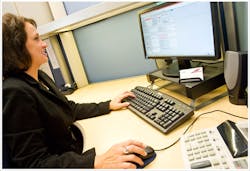This is the third of my three-part series about Firstronic CEO John Sammut, a seasoned manufacturing pioneer who knows how to drive manufacturing growth from operations in the U.S.
Electronics manufacturing services is a low margin business, where overhead cost must be minimized through efficient practices. In the auto and medical sectors especially, project launches are lengthy and complex. Firstronic CEO John Sammut meets this challenge with unique approaches to gaining and keeping customers (the topic of part one in this series), leveraging lean and workforce strategies (the topic of part two), and deploying information technology (the topic of this, part three).
Sammut's IT strategy involves the integration of an of internally-developed program management software with an off-the-shelf cloud-based ERP solution.
Moody: We’d like to know how Firstronic views -- and invests in -- IT.
Sammut: It’s amazing how much you get for $3k per month on the Cloud -- how could somebody not want to do this if access and security is all settled.
The IndustryWeek Leader of the Week highlights the manufacturing leaders, executives and stars who are driving growth in today's industry and helping to shape the future of manufacturing.
In the past when a company was considering an ERP launch, there were multiple six-figure investments, from buying the software and hardware, new servers, plus management costs, etc. We decided that we wanted access to all those bells and whistles and ERP, but we didn’t want to invest in servers, so we looked at Cloud-based ERP, [which is] hosted on a provider’s servers accessed over the web, and we found several good ones that allowed us flexibility online. We found they would scale up to a company’s size, and they actually can change the revenue of a company. At $3k per month, $36k per year, it’s very reasonable.
Moody: Are you concerned with system security?
Sammut: Of course, and we think the provider has an extremely secure network plus the data is constantly backed up. The system we use, PLEX, is located in Auburn Hills, Mich., and it was developed in that region. They have 600 different companies, of which 70% are automotive. Since we have quite a bit of auto business, it’s a good fit because we need high security and redundancy, with off-site storage in Indiana for back-ups, so actually there is triple redundancy.
It’s an incredible system, as powerful as the biggest, SAP. And yes, we included SAP in the evaluation.
With ProManage, [the program management software], we can customize to the electronics industry. That’s important because there is a whole order of complexity in [electronics manufacturing] –- more than in other industries. The Bills of Materials are huge and complex and so is the process, so we developed ProManage to fit on the front end of any industry operation.
We have templates for any task, from launch, to ordering components, evaluation issues, etc, so that a brand new program manager could do this. The system sends milestone updates of things to do which keeps these programs on track.
For example, if an engineering change order is generated, the system will evaluate and give obsolescence cost, all the checkpoints that are specific to electronics.
ProManage is something we developed internally to use with customers. We install it at the customer site, and they can see everything we see. It’s a competitive advantage.
Strategy Reduces Component and Material Obsolescence
Moody: We’re hearing that many companies are struggling with inaccurate or missing Bill of Material and Part Master files. How is Firstronic dealing with this challenge?
Sammut: BOM problems in electronics lead to a lot of obsolescence -- the accumulation of components and material that has no customer; bone piles of material that cost thousands and thousands of dollars, maybe hundreds of thousands.
Not having accurate information or not maintaining the system costs money, but we have our ERP tied to ProManage and that allows us to review anything coming off the customer’s BOM.
We do a quarterly review of any inventory that is excess or obsolete, or no longer in customer assemblies. We can address reimbursements to customers and shut off the pipeline, but this has to be regularly reviewed because obsolescence can be a huge problem.
We use a very simple two bin kanban system that is visual for us to quickly monitor all components in our inventory. This prevents Firstronic from accumulating excess inventory which could ultimately lead to obsolescence.
It’s another tool that helps us remain competitive and lean.
- Automating the program management function to eliminate repetitive tactical tasks<
- Creating a repeatable project launch process
- Efficiently keeping customers "in the loop" on critical project issues
- Providing support for operational efficiency.<
- ERP system
- MES module
- EDI customer and supplier interfaces
- Online quality data collection/reporting tools.
- A cloud-based system, it is accessible by Customers and Firstronic personnel, as needed.






